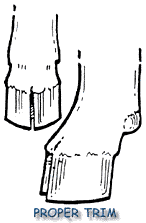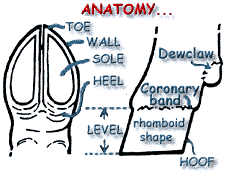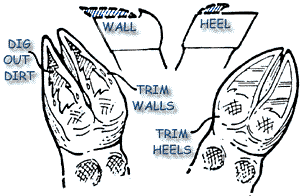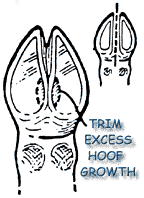 |
||||||||
 |
||||||||
 |
||||||
HEALTHY FEET ARE VITAL TO CAPRINE HEALTH
|
||
Make sure that your goats are all current on their tetanus shots before beginning to trim their hooves. Tetanus lives in the ground, and cut/bleeding hooves are the perfect entry point. Death from tetanus is quick and painful, not to mention avoidable by simply vaccinating all goats on an annual basis. The best time to trim hooves is immediately after a rain or a heavy dew, because the hoof wall will be much softer and therefore easier to cut. Wear gloves to keep from cutting yourself with the sharp hoof trimmers. Struggling goats jerking their legs to free themselves from your grasp can result in injury to both parties. When possible, combine hoof trimming with de-worming, vaccinating with CD/T (overeating & tetanus vaccine), and eartagging; this will reduce handling time. Use a non-permanent crayon-type PAINT STIK in a bright, contrasting color (such as fluorescent pink) to mark the animal on its forehead when you've finished handling him so that you know who has been processed and who hasn't.
Buy a bottle of Kopertox and a container of Blood Stop Powder (Jeffers, Valley Vet, Caprine, Hoeggers) for use on both hoofrot, hoof scald, and cuts. Hoofrot occurs when the hoof wall has grown over the sole of the foot, trapping feces and other material contaminated by bacteria against the soft pad of the hoof. Hoofrot also occurs between the foot and the side wall. It is greyish-blackish in color, has an unmistakably foul odor, and must be completely and carefully removed. Hoof scald occurs between the toes; blood blisters in this area will take a goat completely off its feet and therefore off feed. A doe with hoof problems will not only go downhill herself, but her kids will be badly stunted. Hoof scald must be treated with footbaths of copper sulfate and topical application of Kopertox daily for at least 10 days. Additionally, the goat must receive injections of long-acting Benzathine penicillin to combat infection for at least five days. Hoof trimming is best done in a squeeze chute . . . preferably one that is ramped off the ground to the level of the workers' arms. Alternatively, a milk stand will suffice, or the goat can be placed on its side on the ground, with one person firmly holding it while the other trims the hooves. This latter method is slow and back-breaking work, so try to find a better way or you'll dread (and therefore avoid) hoof trimming chores. Tough-to-cut, out-of-shape hooves may need to be worked on with a hand-held grinder . . . . . . the kind with a 4-inch metal grinding wheel. This is often the only tool that will get Boer hooves back into shape. Stop grinding when the hoof feels hot. The goat will let you know by jerking its leg from your hand! Goats don't like having their hooves trimmed; balancing on three legs irritates them. Holding on to the legs of large bucks can be quite a challenge. Be really careful when using the grinder . . . not just for the goat's safety but also for yours; the grinder can do tremendous damage to your hands and body, too.
Use an electric grinder to flatten the soles and the heel. The goat should walk upright on flat-bottomed feet . . . not on his pasterns. If slight bleeding occurs or hoofrot is encountered, generously apply Kopertox liquid bandage to the entire bottom of the hoof. Hold the hoof off the ground for about 90 seconds to allow this oily blue-green liquid to dry. Kopertox will remain on the hoof approximately 24 hours under normal weather conditions. Re-apply daily as needed. If serious (pulsing) bleeding occurs, apply Blood Stop Powder promptly. Once the bleeding is under control, use Kopertox. Carefully trim the dewclaws one snip at a time. These are often very hard and crusty, and tend to come apart in chunks. Hoof problems can be minimized by using footbaths strategically placed in locations where the goats must walk through them daily. Copper sulfate in solution form (it comes in powder form) works extremely well. Terry Hankins, publisher of GOAT RANCHER magazine, uses full-strength Clorox footbaths on his goats, and follows up with Diatomaceous Earth as a drying agent. Parts of the country receiving high rainfall amounts must take preventative measures against hoofrot and hoof scald. Folks in those areas also should make an extra effort to vaccinate all goats against tetanus. |
||
 |
||||||
 |
||||||
Healthy feet are critical to the |
||||||
 |
||||||
 |
||||||
Important! Please Read This Notice! All information provided in these articles is based either on personal experience or information provided by others whose treatments and practices have been discussed fully with a vet for accuracy and effectiveness before passing them on to readers. In all cases, it is your responsibility to obtain veterinary services and advice before using any of the information provided in these articles. Suzanne Gasparotto is not a veterinarian.Neither tennesseemeatgoats.com nor any of the contributors to this website will be held responsible for the use of any information contained herein. |
||
The author, Suzanne Gasparotto, hereby grants to local goat publications and club newsletters, permission to reprint articles published on the Onion Creek Ranch website under these conditions: THE ARTICLE MUST BE REPRODUCED IN ITS ENTIRETY AND THE AUTHOR'S NAME, ADDRESS, AND CONTACT INFORMATION MUST BE INCLUDED AT THE BEGINNING OF THE REPRINT. We would appreciate notification from any clubs or publications when the articles are used. (A copy of the newsletter or publication would also be a welcome addition to our growing library of goat related information!) |
||
 |
||
All information and photos copyright © Onion Creek Ranch and may not be used without express written permission of Onion Creek Ranch. TENNESSEE MEAT GOAT ™ and TEXMASTER™ are Trademarks of Onion Creek Ranch . All artwork and graphics © DTP, Ink and Onion Creek Ranch. |
||


 Know how you feel when your feet hurt? Well, it's no different for goats. Out-of-shape and overgrown hooves lead to hoofrot and hoof scald . . . and one sick goat! Goats can't forage if they can't move continually, and bad hooves take them down. Goat metabolism is very rapid, so they must be able to stay on the move and browse. Severe hoofrot or hoof scald can actually lead to death; blood blisters can form between the toes, making walking exceedingly painful and competing for food difficult. And goats don't live long when they're not constantly eating.
Know how you feel when your feet hurt? Well, it's no different for goats. Out-of-shape and overgrown hooves lead to hoofrot and hoof scald . . . and one sick goat! Goats can't forage if they can't move continually, and bad hooves take them down. Goat metabolism is very rapid, so they must be able to stay on the move and browse. Severe hoofrot or hoof scald can actually lead to death; blood blisters can form between the toes, making walking exceedingly painful and competing for food difficult. And goats don't live long when they're not constantly eating. Climate and topography of the land affect hoof conditions. Wet climates and farmland conditions greatly increase the need for frequent hoof trimming. Rocky, dry land is best for goats in many ways, including keeping their hooves in good condition. Boers seem to be the exception to this statement . . . even in dry and rocky areas, they require lots of attention to their hooves.
Climate and topography of the land affect hoof conditions. Wet climates and farmland conditions greatly increase the need for frequent hoof trimming. Rocky, dry land is best for goats in many ways, including keeping their hooves in good condition. Boers seem to be the exception to this statement . . . even in dry and rocky areas, they require lots of attention to their hooves. Purchase a quality hoof trimmer. Caprine Supply has a lightweight, rust-resistant trimmer (item #302) with narrow, teflon-coated blades that are very sharp and can be re-sharpened for repeated use. The pointed ends of the trimmer can be used for cleaning out dirt and debris embedded in the hooves, and the narrow blade helps make cutting more accurate. They are 7-1/2 inches long and cost about $20/pair. Caprine Supply can be reached at 1-800-646-7736. Their bright orange handles make them hard to misplace.
Purchase a quality hoof trimmer. Caprine Supply has a lightweight, rust-resistant trimmer (item #302) with narrow, teflon-coated blades that are very sharp and can be re-sharpened for repeated use. The pointed ends of the trimmer can be used for cleaning out dirt and debris embedded in the hooves, and the narrow blade helps make cutting more accurate. They are 7-1/2 inches long and cost about $20/pair. Caprine Supply can be reached at 1-800-646-7736. Their bright orange handles make them hard to misplace. The first step to take when trimming hooves is to clean all dirt from the sole and between the toes with the point of the hoof trimmer. If the hoof wall is overgrown, carefully pry it open and cut it off -- one small slice at a time. Don't get in a hurry, take big cuts, and cause the hoof to bleed. Keep both Kopertox and Blood Stop Powder handy. Stop trimming when the sole appears pinkish and all hoofrot has been removed. Hoofrot is normally found near the tip of the toe and along the hoof walls; it seldom occurs at the heel.
The first step to take when trimming hooves is to clean all dirt from the sole and between the toes with the point of the hoof trimmer. If the hoof wall is overgrown, carefully pry it open and cut it off -- one small slice at a time. Don't get in a hurry, take big cuts, and cause the hoof to bleed. Keep both Kopertox and Blood Stop Powder handy. Stop trimming when the sole appears pinkish and all hoofrot has been removed. Hoofrot is normally found near the tip of the toe and along the hoof walls; it seldom occurs at the heel. Trim between the hooves where the heels meet, taking care, as the heels are softer than any other part of the hoof. If in doubt about what a goat's hoof should look like, examine a very young kid's hoof.
Trim between the hooves where the heels meet, taking care, as the heels are softer than any other part of the hoof. If in doubt about what a goat's hoof should look like, examine a very young kid's hoof.